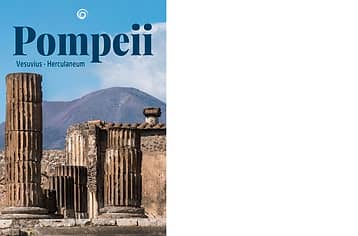- Home
- Free Pompeii and Herculaneum guidebook
Free Pompeii and Herculaneum guidebook

Welcome to our comprehensive web page where you can download a free PDF ebook guide to the awe-inspiring ruins of Pompeii and Herculaneum in Italy. This detailed guide will provide you with valuable insights and tips to help you decide whether to visit Pompeii or Herculaneum, both of which were buried under the volcanic ash of the eruption of Mount Vesuvius. Our Pompeii guide will show you how to make the most of your exploration of this ancient city in the Campania region.
Download free guide
PDF format, 6.2MB
It's truly free, your email is not required to download.
Our ebook covers topics such as visiting the ancient Roman ruins of Pompeii and Herculaneum, indulging in a wine tasting at Cantina del Vesuvio Winery, and climbing Mount Vesuvius. We provide essential information on getting to these historic sites and even suggestions for day trips to nearby Naples, the Royal Palace of Caserta, and Paestum. Get ready for a wonderful visit to Pompeii and Herculaneum by downloading your free guide today!
Index
Should I visit Pompeii or Herculaneum?
Visiting the Ruins of Pompeii
Cantina del Vesuvio Winery
Mount Vesuvius
Visiting The Ruins of Herculaneum
Getting to Pompeii, Herculaneum, and Vesuvius
FAQ about Pompeii, Herculaneum, and Vesuvius
A day trip to Naples
The Royal Palace of Caserta
Paestum
The authors
This Pompeii guide was written by passionate local experts who live and work on Capri and the Amalfi Coast. Our comprehensive guide will help you make the most of your visit, taking in all the sights, including the magnificent frescoes, the Forum Baths, the Lupanar, the Villa of the Mysteries, and the plaster casts from the excavations — all from the perspective of local authors who are experts in this ancient Roman city and visiting Pompeii.
Instant download
Download the guide in PDF format on any device and take it with you!
Download free guide
PDF format, 6.2MB
Free Pompeii and Herculaneum guidebook in Italian
More free guides:
Free Amalfi Coast Guidebook
Free Sorrento Guidebook
Free Capri Guidebook
Choosing between Pompeii and Herculaneum
Choosing between Pompeii and Herculaneum
Deciding whether to visit Pompeii or Herculaneum can be a difficult choice. Both archaeological sites offer a unique and fascinating look into life in ancient Rome. Here are a few key differences to consider to help you decide.
Dimensions and structure
The first big difference between Pompeii and Herculaneum lies in their size: the excavations, or scavi, of Pompeii cover an area of about 44 hectares of land, while Herculaneum covers only 4 hectares.
Pompeii was a large and prosperous commercial city, while Herculaneum was a small holiday resort. The Herculaneum archaeological site lacks the large structures that Pompeii had, such as the forum and the amphitheatre.
Preservation of the buildings
Herculaneum’s strong suit is how well the buildings have been preserved. The ancient city was buried by a flow of lava and mud that covered and filled all the buildings without damaging them. Pompeii, on the other hand, was buried by a burning cloud of ash, pumice, and lapilli. This brought down all the upper floors and burned the wooden parts, which remained intact in Herculaneum.
Making the choice
In the end, if you have to choose just one archaeological site, we recommend Pompeii. Herculaneum can be a good option if you can't walk far or if the climate is particularly hot (Herculaneum has more places to shelter in the shade than Pompeii).
To visit Pompeii, we absolutely recommend hiring a tour guide for your walking tour. For Herculaneum, an audio guide may be sufficient. If you are passionate about ancient history, you can also consider visiting the excavations of Stabia, Oplonti and the National Archaeological Museum in Naples, where the artifacts found during the excavations are kept.
We advise against attempting to visit Pompeii and Herculaneum on the same day; it would be too tiring an itinerary.
Visiting Pompeii
Visiting Pompeii
This ancient archaeological site is one of the most famous in the world, offering an incredibly detailed picture of daily life in ancient Rome. Here are the most important points to visit in the archaeological park of Pompeii:
The Forum
The amphitheater
The garden of the fugitives with casts
The house of the faun
The House of Vets
The thermal baths with calidarium, frigidarium and tepidarium
The temple of Jupiter
The temple of Venus
The temple of Isis
Visiting the city of Herculaneum
Visiting the city of Herculaneum
Though smaller and less famous than Pompeii, Herculaneum offers a unique insight into life in ancient Rome, with many perfectly preserved buildings. Here are the the most important points to see during your visit:
House of the Telephus Relief
House of the Samnites
The seat of the augustali
The men's baths
How to reach Pompeii and Herculaneum
How to reach Pompeii and Herculaneum
Pompeii and Herculaneum are easily reached by train from Naples and Sorrento. If you arrive by car, there are parking lots near the entrances to the archaeological sites.
By train
The Circumvesuviana railway line connects Naples and Sorrento, with stops near the archaeological sites of Pompeii and Herculaneum. From the Pompeii Villa dei Misteri station, the Porta Marina Superiore entrance is exactly opposite, while the Porta Marina Inferiore entrance (Piazza Esedra) is just a few meters away.
By car
If arriving by car, the A3 Pompei Ovest highway exit leads directly to the archaeological park entrance, and there are numerous car parks near the entrances. Reaching Herculaneum by car can be a bit trickier, as you have to navigate through the traffic of the modern city center. Once near the entrance to the archaeological ruins, there are plenty of parking spaces.